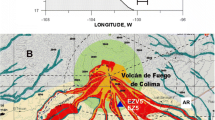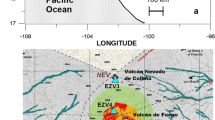Abstract
Volcán de Colima is one of the most active volcanoes in Mexico, not only for its eruptive history, but also for its annual occurrence of lahars. This makes the volcano a natural laboratory for monitoring and studying lahar processes. Since 2011, monitoring instruments have been deployed along the highly active Montegrande ravine, with at least three lahar events per year. Here, we report the datasets of three events collected during the 2012 and 2013 seasons, then interpret the acquired data. An event classification scheme based on lahar magnitude, duration and seismic characteristics is presented to distinguish “single-pulse” events (SPEs) from “multi-pulse” events (MPE). SPEs lasted approximately 60 min, had average velocities of ~2 m/s and mean peak discharges of ~24 m3/s. MPEs endured for more than 3 h, reached mean velocities of ~4.5 m/s and peak discharges of ~60 m3/s (for block-rich surges). The seismic signal-analysis also allowed us to discriminate physical flow fluctuations within single lahars, i.e. between the arrival of block-rich fronts and subsequent variations in flow discharge. The exponential regression analysis showed a best fit, with correlation coefficients around 0.92 and exponential coefficients of ~0.01 s, for the block-rich fronts, with seismic amplitudes increasing from 4.8 × 10−4 to 2.3 × 10−3 m/s and frequency ranges from 10 to 20 Hz. The variations in flow discharge were distinguished by lower amplitudes of ~5.7 × 10−4 m/s than those of the block-rich fronts and with frequency ranges of 10–40 Hz. The results presented in this paper demonstrate that the seismic data of events allowed us to describe and discriminate among different flow types; these records are thus a useful investigation tool for lahar events that have a seismic record but are not observed directly. We propose that a seismic early warning system can be developed to help civil protection authorities in designing risk mitigation strategies.







Similar content being viewed by others
References
Abancó C, Hürlimann M, Fritschi B, Graf C, Moya J (2012) Transformation of ground vibration signal from debris-flow monitoring and detection in alarm systems. Sensors (Basel) 12:4870–4891. doi:10.3390/s120404870
Arattano M (1999) On the use of seismic detectors as monitoring and warning systems for debris flows. Nat Hazards 20:197–213
Arattano M (2000) On debris flow front evolution along a torrent. Phys Chem Earth (B) 25:733–740
Arattano M, Marchi L (2005) Measurements of debris flow velocity through cross-correlation of instrumentation data. Nat Hazards Earth Syst Sci 5:137–142
Arattano M, Marchi L (2008) Systems and sensors for debris-flow monitoring and warning. Sensors 8:2436–2452
Arattano M, Moia F (1999) Monitoring the propagation of a debris flow along a torrent. Hydrol Sci J 44:811–823
Arattano M, Marchi L, Cavalli M (2012) Analysis of debris-flow recordings in an instrumented basin: confirmations and new findings. Nat Hazards Earth Syst Sci 12:679–686
Beverage J, Culbertson J (1964) Hyperconcentrations of suspended sediment. Am Soc Civ Eng 90:117–126
Brigham EO (1974) The fast Fourier transform. Prentice-Hall, Englewood Cliffs
Caballero L, Capra L (2014) The use of FLO2D numerical code in lahar hazard evaluation at Popocatépetl volcano: a 2001 lahar scenario. Nat Hazards Earth Syst Sci 14:3345–3355
Capra L, Poblete MA, Alvarado R (2004) The 1997 and 2001 lahars of Popocatépetl volcano (Central Mexico): textural and sedimentological constraints on their origin and hazards. J Volcanol Geotherm Res 131:351–369
Capra L, Borselli L, Varley N, Gavilanes-Ruiz JC, Norini G, Sarocchi D, Caballero L, Cortes A (2010) Rainfall-triggered lahars at Volcán de Colima, Mexico: surface hydro-repellency as initiation process. J Volcanol Geotherm Res 189:105–117
Capra L, Roverato M, Gropelli G, Sulpizio R, Arámbula-Mendoza R, Reyes G, Lube G, Cronin SJ (2013) Hurricane-triggered lahars at Volcán de Colima: evidences of flow dynamic from monitoring and field survey. Abstract with program IAVCEI, Kagoshima, Japan
Cole SE (2011) Geophysical investigation into the internal dynamics of moving lahars. Thesis for Doctoral Department of Soil and Earth Science, Massey University, Palmerston North N.Z, p 187
Cole S, Cronin S, Sherburn S, Manville V (2009) Seismic signals of snow-slurry lahars in motion: 25 Sept. 2007, Mt. Ruapehu. N Z Geophys Res Lett 36:L09405. doi:10.1029/2009GL038030
Costa JE (1984) Physical geomorphology of debris flows. In: Costa JE, Fleisher PJ (eds) Developments and applications of geomorphology. Springer, Berlin, pp 268–317
Davila N, Capra L, Gavilanes-Ruiz JC, Varley N, Norini G, Gómez-Vazquez A (2007) Recent lahars at Volcán de Colima (Mexico): drainage variation and spectral classification. J Volcanol Geotherm Res 165:127–141
Doyle EE, Cronin SJ, Cole SE, Thouret JC (2010) The coalescence and organization of lahars at Semeru volcano, Indonesia. Bull Volcanol 72:961–970
Doyle EE, Cronin SJ, Thouret J-C (2011) Defining conditions for bulking and debulking in lahars. Geol Soc Am Bull 123:1234–1246
Dumaisnil C, Thouret J-C, Chambon G, Doyle EE, Cronin SJ, Surono (2010) Hydraulic, physical and rheological characteristics of rain-triggered lahars at Semeru volcano, Indonesia. Earth Surf Process Landf 35:1573–1590
Galgaro A, Tecca PR, Genevois R, Deganutti AM (2005) Acoustic module of the Acquabona (Italy) debris flow monitoring system. Nat Hazards Earth Syst Sci 5:211–215
Huang C-J, Yin H-Y, Chen C-Y, Yeh C-H, Wang C-L (2007) Ground vibrations produced by rock motions and debris flows. J Geophys Res 112, F02014. doi:10.1029/2005JF000437
Itakura Y, Koga Y, Takahama J, Nowa Y (1997) Acoustic detection sensor for debris flow. In: Chen CL (ed) Debris-flow hazard mitigation: mechanics, prediction and assessment. ASCE, New York, pp 747–756
Iverson RM (1997) The physics of debris flows. Rev Geophys 35:245–296
Iverson RM, Reid ME, LaHusen RG (1997) Debris-flow mobilization from landslides. Annu Rev Earth Planet Sci 25:85–138
Kean JW, Coe JA, Coviello V, Smith JB, McCoy SW, Arattano M (2015) Estimating rates of debris flow entrainment from ground vibrations. Geophys Res Lett 42:6365–6372. doi:10.1002/2015GL0644811
Kogelnig A, Hübl J, Suriñach E, Vilajosana I, McArdell BW (2011) Infrasound produced by debris flow: propagation and frequency content evolution. Nat Hazards. doi:10.1007/s11069-011-9741-8
LaHusen RG (1996) Detecting debris flows using ground vibrations. USGS Fact Sheet :236–296
LaHusen RG (2005) Debris-flow instrumentation. In: Jakob M, Hungr O (eds) Debris-flows hazards and related phenomena. Springer, Berlin, pp 291–304
Lavigne F, Suwa H (2004) Contrasts between debris flows, hyperconcentrated flows and streamflows at a channel of Mount Semeru, East Java, Indonesia. Geomorphology 61:41–58
Lavigne F, Thouret J-C, Voight B, Young K, LaHusen R, Marso J, Suwa H, Sumaryono A, Sayudi DS, Dejean M (2000) Instrumental lahar monitoring at Merapi Volcano. J Volcanol Geotherm Res 100:457–478
Lavigne F, Tirel A, Le Floch D, Veryat-Charvillon S (2003) A real-time assessment for lahar dynamics and sediment load based on video-camera recording at Semeru volcano, Indonesia. In: Rickenmann D, Chen CL (eds) Debris-flow hazards mitigation: mechanics, prediction and assessment. Millpress, Rotterdam, pp 871–882
Marchi L, Arattano M, Deganutti AM (2002) Ten years of debris-flow monitoring in the Moscardo Torrent (Italian Alps). Geomorphology 46:1–17
Marcial S, Melosantos AA, Hadley KC, LaHusen RG, Marso N (1996) Instrumental lahar monitoring at Mount Pinatubo. In: Newhall CG, Punongbayan RS (eds) Fire and mud: eruptions and lahars of Mount Pinatubo, Philippines. University of Washington Press, Seattle, pp 1015–1022
Newhall CG, Punongbayan RS (1996) Fire and mud eruptions and lahars of Mount Pinatubo. University of Washington Press, Philippines
Okuda S, Suwa H, Okunishi K, Yokoyama K, Nakano M (1980) Observations on the motion of a debris flow and its geomorphological effects. Z Geomorphol Suppl 35:142–163
Pierson TC (1986) Flow behavior of channelized debris flows, Mount St. Helens, Washington. In: Abrahams AD (ed) Hillslope processes. Allen and Unwin, Boston, pp 269–296
Pierson TC, Costa JE (1987) A rheologic classification of subaerial sediment-water flows. Geol Soc Am Rev Eng Geol 7:1–12
Sabot F, Naaim M, Granada F, Suriñach E, Planet P, Furdada G (1998) Study of avalanche dynamics by seismic methods, image-processing techniques and numerical models. Ann Glaciol 26:319–323
Smith GA, Lowe DR (1991) Lahars: volcano-hydrologic events and deposition in the debris flow-hyperconcentrated flow continuum. In: Fisher RV, Smith GA (eds) Sedimentation in volcanic settings, SEPM Special Publication, vol 45. Soc Sed Geol Tulsa, p 59–70
Suriñach E, Sabot F, Furdada G, Vilaplana JM (2000) Study of seismic signals of artificially released snow avalanches for monitoring purposes. Phys Chem Earth 25:721–727
Suriñach E, Furdada G, Sabot F, Biescas B, Vilaplana JM (2001) On the characterization of seismic signals generated by snow avalanches for monitoring purposes. Ann Glaciol 32:268–274
Suriñach E, Vilajosana I, Khazaradze G, Biescas B, Furdada G, Vilaplana JM (2005) Seismic detection and characterization of landslides and other mass movements. Nat Hazards Earth Syst Sci 5:791–798
Suwa H, Okuda S (1985) Measurement of debris flows in Japan. Proc. IV international Conference and Field Workshop on Landslides, Tokyo, p 391–400
Suwa H, Yamakoshi T, Sato K (2000) Relationship between debris-flow discharge and ground vibration. In: Wieczorek G, Naeser N (eds) Debris-flow hazards mitigation: mechanics, prediction and assessment. Millpress, Rotterdam, pp 311–318
Tuñgol NM, Regalado MT (1996) Instrumental lahar monitoring at Mount Pinatubo. In: Newhall CG, Punongbayan RS (eds) Fire and mud: eruptions and lahars of Mount Pinatubo. University of Washington Press, Philippines, pp 1023–1032
Vallance JW (2005) Volcanic debris flows. In: Jakob M, Hungr O (eds) Debris-flows hazards and related phenomena. Springer, Berlin, pp 247–272
Vázquez R, Capra L, Caballero R, Arámbula-Mendoza R, Reyes-Dávila G (2014) The anatomy of a lahar: deciphering the 15th September 2012 lahar at Volcán de Colima, Mexico. J Volcanol Geotherm Res 272:126–136
Zobin VM, Plascencia I, Reyes G, Navarro C (2009) The characteristics of seismic signals produced by lahars and pyroclastic flows: Volcán de Colima, México. J Volcanol Geotherm Res 179:157–167
Acknowledgments
This work was supported by the CONACyT 99486, PAPIIT-UNAM IN-106710, and SRE-CONACyT 146324 projects to Lucia Capra. The Spanish MINECO project CGL2013-40828-R partially supported this investigation. Thanks to the staff of Centro Nacional de Prevención de Desastres (CENAPRED) for the instrumentation setup in the Montegrande monitoring site. Thanks to Penélope López for managing the Spot image acquisition from ERMEX-SPOT IMAGE S.A. The first author spent 6 months in the Departament de Geodinàmica i Geofísica, at Universitat de Barcelona, and wish to thank them for the support during that time. Special thanks to the associate editor Gert Lube for handling this paper and the two anonymous reviewers for insightful comments that greatly improved this work.
Author information
Authors and Affiliations
Corresponding author
Additional information
Editorial responsibility: G. Lube
Electronic supplementary material
Below is the link to the electronic supplementary material.
ESM 1
(PDF 13125 kb)
Rights and permissions
About this article
Cite this article
Vázquez, R., Suriñach, E., Capra, L. et al. Seismic characterisation of lahars at Volcán de Colima, Mexico. Bull Volcanol 78, 8 (2016). https://doi.org/10.1007/s00445-016-1004-9
Received:
Accepted:
Published:
DOI: https://doi.org/10.1007/s00445-016-1004-9




